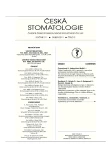Cytotoxicity of Ceramic Materials
Authors:
L. Vavřičková 1; T. Dostálová 2; J. Ulrichová 3
Authors‘ workplace:
Stomatologická klinika LF UK a FN, Hradec Králové
1; Dětská stomatologická klinika 2. LF UK a FN Motol, Praha
2; Laboratoř buněčných kultur LF UP, Olomouc
3
Published in:
Česká stomatologie / Praktické zubní lékařství, ročník 111, 2011, 2, s. 46-52
Category:
Original Article – Experimental Study
Overview
Paper presents cytotoxicity testing procedure in vitro of preselected dental ceramics. Direct contact test and extract test were monitored. A population of mouse fibroblasts NIH 3T3 was used for both tests. Results show all tested dental ceramics can be considered non-cytotoxic, except the lithium disilicate material.
Key words:
cytotoxicity, dental ceramics
Sources
1. Brackett, M. G., Lockwood, P. E. et al.: In vitro cytotoxicity response to lithium disilicate dental ceramics. Dent. Mater., 24, 2008, 4, s. 450-456.
2. Covacci, V., Bruzzese, N. et al.: In vitro evaluation of mutagenic and cancerogenic power of high purity zirconia ceramic. Biomaterials, 20, 1999, 4, s. 371-376.
3. Denry, I, Kelly, J. R.: State of the art of zirconia for dental applications. Dent. Mater., 24, 2008, s. 299-307.
4. Deville, S., Chevalier, J., Gremillard, L.: Influence of surface finish and residual stresses on the ageing sensitivity of biomedical grade zirconia. Biomaterials, 27, 2006, s. 2186-2192.
5. Elshahawy, W. M., Watanabe, I. a kol.: In vitro cytotoxicity evaluation of elemental ions released from different prosthodontic materials. Dent. Mater., 25, 2009, 12, s. 1551-1555.
6. Garvie, R. C., Nicholson, P. S.: Phase analysis in zirconia systems. J. Am. Ceram. Soc., 55, 1972, s. 303-305.
7. Hammerle, Ch., Sailer, I. et al: Dental ceramics. Quintessence Publishing, ISBN 987-1-85097-181-8.
8. Chong, K. H., Chai, J., Takahashi, Y., Wozniak, W.: Flexural strength of In-Ceram alumina and In-Ceram zirconia core materials. Int. J. Prosthodont, 15, 2002, s. 183-188.
9. Messer, R. L., Lockwood, P. E. et al.: In vitro cytotoxicity of traditional versus contemporary dental ceramics. J. Prosthet. Dent., 90, 2003, 5, s. 452-458.
10. Ryge, G., Cvar, J. F.: Criteria for clinical evaluation of dental restorative materials. US Dental health Center, Publication No.7902244, San Francisco, USA.
11. Sato, T., Ohtaki, S., Shimada, M.: Transformation of yttria-partially-stabilized zirconia by low-temperature annealing in air. J. Mater. Sci., 20, 1985, s. 1466-470.
12. Sato, T., Shimada, M.: Crystalline phase-change in yttria-partially-stabilized zirconia by low-temperature annealing. J. Am. Ceram Soc., 67, 1984, s. 212-213.
13. Uo, M., Sjogren, G. et al.: Cytotoxicity and boxing property of dental ceramics. Dent. Mater., 19, 2003, 6, s. 487-492.
14. Vavřičková, L., Dostálová, T., Vahalová, D., Šrámková, J., Ulrichová, J.: Cytotoxicita dentálních slitin, Čes. Stomat., 107, 2007, 6, s. 138-143.
15. Vavřičková, L., Pilathadka, S., Dostálová, T.: Celokeramické systémy v klinické praxi. LKS., 18, 2008, 10 (Suppl.), s. A5-A11.
Labels
Maxillofacial surgery Orthodontics Dental medicineArticle was published in
Czech Dental Journal

2011 Issue 2
- What Effect Can Be Expected from Limosilactobacillus reuteri in Mucositis and Peri-Implantitis?
- The Importance of Limosilactobacillus reuteri in Administration to Diabetics with Gingivitis
Most read in this issue
- Halitosis - Present View of the Etiology, Diagnosis and Therapy
- Gutta-percha in Dentistry
- Cytotoxicity of Ceramic Materials
- Malignant Lymphomas of Non-Hodgkin Type in the Annals of Stomatology Clinic in Hradec Králové 1998–2008
